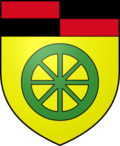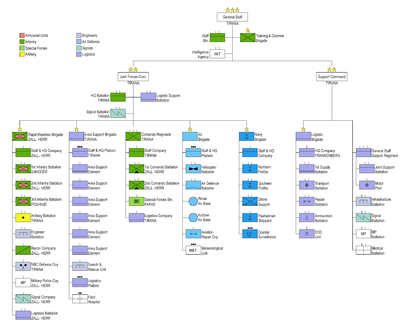- Albanian Joint Forces Command
-
Albanian Joint Forces Command
Komanda e Forcës së Bashkuar
Coat of Arms of the Albanian Joint Forces CommandActive 2006 - Country  Albania
AlbaniaAllegiance Albanian Armed Forces Branch Land Forces
Air Force
Naval Defense ForcesType Unified Combatant Command Headquarters Tirana Website http://www.gs.mil.al Commanders General Maksim Malaj The Albanian Joint Forces Command, consists in the branch of the Albanian Armed Forces charged with protecting the territorial integrity of Albania. The Command has under the proper structure the Rapid Reaction Brigade, the Commando Regiment, the Albanian Air Force, the Albanian Naval Defense Forces and the Area Support Brigade.
Contents
History
Albania requested a Defense Assessment from the USA in coordination with NATO (Allied Command Transformation) and NATO Headquarter Tirana, early in 2006 in order to ensure that previous reform efforts were proceeding well and to provide for course corrections if needed. Conclusions of this work encouraged both Ministry of Defence and General Staff of AAF to continue refining force structure and reducing the size of the Armed Forces by reducing staffs and removing obsolete units making the resultant force more capable and affordable.
A major element of this restructure process was the development of a Joint Forces Command. This streamlined the command and the control of operational units, by contributing more effectively to NATO led Peace Support Operations.
Another key element of this restructuring was the consolidation of almost all units under three major commands; the Joint Forces Command, the Albanian Training and Doctrine Command, and the Albanian Logistic Support Command, thus enhancing supervision of subordinate units and reducing the span of control of the General Staff.
Basic History
In 1999, (based on the old structure The Albanian Land Forces were the main Albanian Armed Forces battle component), the AAF were in alert due to a possible military confrontation with Yugoslavia over the contested territory of Kosovo. Previous preparations during the 90's, included the purchase of the Chinese antitank missile HJ-8, and the antiaircraft HN-5, an improved version of the Russian SA-7. During the 1998-1999 Kosovo War a vast part of the Albanian Armed Forces were deployed along the Albanian-Yugoslavian border.
Developments
The Albanian Land Forces used to field more than 721 Type 59 Main Battle Tanks and 130 M113 Armoured Personal Carriers. Most of the Cold War-era equipment from the Soviet Union and China has been retired or put in storage some has been scraped or sold off. With the new structure, the Albanian Armed Forces does not keep any main battle tanks on active duty although they are in reserve. Antitank weaponry, also combined with Helicopter capability will be the priority. Albania is now a member of NATO[1] and procedures for the acquisition of a new APC in order to achieve the standards required for troop training are underway to achieve the necessary compatibility with NATO equipment standards.
Weapons
Small arms
- TT-33 Main service sidearm
- Makarov PM Used by National Guard
- Beretta 92 Used by special forces
- MP5 Used by special forces
- MP7 Used by special forces
- AK-74 service rifleMain
- AK-47 service rifleMain
- AKM Main service rifle
- Type 56 Main service rifle
- HK G36 Used by special forces
- ARX-160 Used by Albanian troops in Afganistan
- HK 416 Evalution only
- HK 417 Used as sniper by special forces
- Dragunov SVD Main service sniper
- RPK Main service LMG
- DShKM Being withdrawn from service
- DP-27 Being withdrawn from service
- PKM Moderately used
- KPVT Being withdrawn from service
- ZU-23-2 Main service AA gun
- HN-5 Being withdrawn from service
- RPG-7 Main service AT weapon
- HJ-8 Moderately used
- SG-43
Artillery
- Type 67 Main service mortar
- M-46 100 Type 59-1
- D-20 Chinese and Soviet manufactured
- D-1 Being withdrawn from service
- ML-20 Withdrawned from service
- M-30 Withdrawned from service
- D-44 Main service field gun
Vehicles
Manpower and equipment
As of 2005, the Land Forces Command had:[2]
- 16,000 + active personnel and 35,000 reserves:[3].
On 2010 the Joint Forces Command authorized personnel strength will be approximately 8,200. (With the new structure, the 5 Reserve Brigades have been deactivated)
Structure
See also
References
- ^ http://www.mod.gov.al/eng/industria/november2004.asp
- ^ The World Defence Almanac 2006, page. 95, Mönch Publishing Group, Bonn 2006
- ^ The Centre for SouthEast European Studies
External links
- Land Forces Command
- Ministry of Defence of Albania (official site)
- Centre for SouthEast European Studies: Albanias Armed Forces- 2002 Data
- Demilitarization of Albania- Equipment destroyed in 2004
Armies (land forces) in Europe Sovereign
states- Albania
- Andorra
- Armenia
- Austria
- Azerbaijan
- Belarus
- Belgium
- Bosnia and Herzegovina
- Bulgaria
- Croatia
- Cyprus
- Czech Republic
- Denmark
- Estonia
- Finland
- France
- Georgia
- Germany
- Greece
- Hungary
- Iceland
- Ireland
- Italy
- Kazakhstan
- Latvia
- Liechtenstein
- Lithuania
- Luxembourg
- Macedonia
- Malta
- Moldova
- Monaco
- Montenegro
- Netherlands
- Norway
- Poland
- Portugal
- Romania
- Russia
- San Marino
- Serbia
- Slovakia
- Slovenia
- Spain
- Sweden
- Switzerland
- Turkey
- Ukraine
- United Kingdom
- Vatican City
States with limited
recognition- Abkhazia
- Kosovo
- Nagorno-Karabakh Republic
- Northern Cyprus
- South Ossetia
- Transnistria
 Albania topics
Albania topics- Index
- Outline
Symbols People History - Origins
- Praevalitana
- Epirus Nova
- Middle Ages
- Albania under the Bulgarian Empire
- Albania under the Serbian Empire
- Principality of Arbër
- Kingdom of Albania
- Albanian Principalities in Middle Ages
- League of Lezhë
- Venetian Albania
- Ottoman Albania
- Albanian Pashaliks
- Massacre of the Albanian Beys
- Albanian National Awakening
- Revolts of 1833–1839
- Revolt of 1843–1844
- Revolt of 1847
- League of Prizren
- League of Peja
- Revolt of 1910
- Battle of Deçiq
- Independence Declaration
- Provisional Government of Albania
- Albania during the Balkan Wars
- Principality of Albania (1914–1925)
- Italian Protectorate on southern Albania
- Vlora War
- Republic of Mirdita
- Albanian Republic (1925–1928)
- Albanian Kingdom (1928–1939)
- Albania under Italy (Invasion
- Colonization)
- Albania under Germany
- Resistance
- Communist Albania (1946–1992)
- Post-Communist Albania (since 1992)
- Timeline to 1993, 1994–Present
Politics Geography - Cities:
- Geographical Regions:
- Northern Mountain Range
- Southern Mountain Range
- Western Lowlands
- Central Mountain Range
- Mountains:
- Seas:
- Rivers:
- Drin River
- Buna River
- Vjosë
- Black Drin
- Lakes:
- Lake Skadar
- Lake Ohrid
- Lake Prespa
- Lagoons:
- Karavasta
- Narta
- Plains:
- Myzeqe
- Korçë Plain
- Zadrima
- Capes:
- Cape of Gjuhëz
- Cape of Rodon
- National Parks:
- Butrint
- Lura
- Llogara
- Thethi
- Valbona Valley
- Shebenik-Jabllanica
- Fir of Hotova
- Karaburun-Sazan
Economy Military - Military
- Air Force
- Rapid Reaction Brigade
- Naval Defense Forces
- Joint Forces Command
- Support Command
Culture - Languages
- Costume
- Nationalism
- Literature
- Cinema
- Cuisine
- Emigration
- Music
- Sports
- Holidays
- Religion
- Television
- Radio
- Mythology
- Epic Poetry
Religion - Islam
- Albanian Orthodox Church
- Roman Catholicism
- Protestanism
- Byzantine Catholicism
Categories Categories:
Wikimedia Foundation. 2010.

